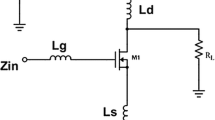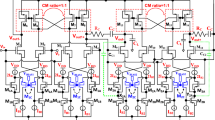Abstract
A novel structure is presented to optimize the noise and linearity performance of a \({\text{g}}_{\text{m}}\)-boosted common gate (CG) ultra-wide-band low noise amplifier (LNA) by exploiting noise and distortion canceling technique. The \({\text{g}}_{\text{m}}\)-booster common source amplifier provides a degree of freedom to eliminate the limitation on the noise figure (NF) improvement, at a lower transconductance for the CG transistor. The applied noise and distortion canceling technique to the \({\text{g}}_{\text{m}}\)-boosted topology is used to minimize the dominant noise contribution and the second and third order non-linearity coefficients of the first stage components. The proposed LNA is configured in a differential topology to compensate the \(IIP_{2}\) of the structure. The Forward body bias technique is utilized for operating the LNA at a lower supply voltage and power consumption. The post-layout simulation results of the LNA, including bonding and electrostatic discharge circuits, with 90 nm TSMC RF CMOS technology show a power gain of 14.5 ± 05 dB, flat NF of 2.2 ± 0.1 dB, and \(S_{11}\) less than − 9.5 dB for 3–5 GHz frequency at a power consumption of 13.8 mW from 0.7 V supply voltage. The \(IIP_{3}\) and \(IIP_{2}\) measures are obtained as + 5.2 dBm and 55 dBm, respectively.






















Similar content being viewed by others
References
Zokaei, A., Amirabadi, A., & Ghasemzadeh, M. (2015). A 130 nm wideband fully differential linear low noise amplifier. In 2015 22nd international conference mixed design of integrated circuits & systems, IEEE (pp. 229–233). https://doi.org/10.1109/mixdes.2015.7208516.
Rastegar, H., Saryazdi, S., & Hakimi, A. (2013). A low power and high linearity UWB low noise amplifier (LNA) for 3.1-10.6 GHz wireless applications in 0.13 μm CMOS process. Microelectronics Journal, 44, 201–209. https://doi.org/10.1016/j.mejo.2013.01.004.
Nakhlestani, A., Hakimi, A., & Movahhedi, M. (2012). A novel configuration for UWB LNA suitable for low-power and low-voltage applications. Microelectronics Journal, 43, 444–451. https://doi.org/10.1016/j.mejo.2012.04.004.
Wan, Q., Wang, Q., & Zheng, Z. (2015). Design and analysis of a 3.1–10.6 GHz UWB low noise amplifier with forward body bias technique. AEU-International Journal of Electronics and Communications, 69, 119–125. https://doi.org/10.1016/j.aeue.2014.08.001.
Pandey, S., & Singh, J. (2015). A low power and high gain CMOS LNA for UWB applications in 90 nm CMOS process. Microelectronics Journal, 46, 390–397. https://doi.org/10.1016/j.mejo.2015.01.002.
Lee, J.-Y., Park, H.-K., Chang, H.-J., & Yun, T.-Y. (2012). Low-power UWB LNA with common-gate and current-reuse techniques. IET Microwaves, Antennas and Propagation, 6, 793. https://doi.org/10.1049/iet-map.2011.0415.
Saberkari, A., Kazemi, S., Shirmohammadli, V., & Yagoub, M. C. E. (2016). gm-boosted flat gain UWB low noise amplifier with active inductor-based input matching network. Integration, the VLSI Journal, 52, 323–333. https://doi.org/10.1016/j.vlsi.2015.06.002.
Shim, J., Yang, T., & Jeong, J. (2013). Design of low power CMOS ultra wide band low noise amplifier using noise canceling technique. Microelectronics Journal, 44, 821–826. https://doi.org/10.1016/j.mejo.2013.06.001.
Chung, T., Lee, H., Jeong, D., Yoon, J., & Kim, B. (2015). A wideband CMOS noise-canceling low-noise amplifier with high linearity. IEEE Microwave and Wireless Components Letters, 25, 547–549. https://doi.org/10.1109/LMWC.2015.2440762.
Bruccoleri, F., Klumperink, E. A. M., & Nauta, B. (2004). Wide-band CMOS low-noise amplifier exploiting thermal noise canceling. IEEE Journal of Solid-State Circuits, 39, 275–282. https://doi.org/10.1109/JSSC.2003.821786.
Aparin, V., Brown, G., Larson, L.E. (2004). Linearization of CMOS LNA’s via optimum gate biasing. In 2004 IEEE international symposium on circuits and systems. (IEEE Cat. No.04CH37512), IEEE( p. IV-748-51). https://doi.org/10.1109/iscas.2004.1329112.
Zhang, H., & Sanchez-Sinencio, E. (2011). Linearization techniques for CMOS low noise amplifiers: A tutorial. IEEE Transactions on Circuits and Systems I: Regular Papers, 58, 22–36. https://doi.org/10.1109/TCSI.2010.2055353.
Parvizi, M., & Nabavi, A. (2009). Improved derivative superposition scheme for simultaneous second- and third-order distortion cancellation in LNAs. Electronics Letters, 45, 1323. https://doi.org/10.1049/el.2009.1921.
Gao, W., Chen, Z., Liu, Z., Cui, W., & Gui, X. (2015). A highly linear low noise amplifier with wide range derivative superposition method. IEEE Microwave and Wireless Components Letters, 25, 817–819. https://doi.org/10.1109/LMWC.2015.2496793.
Rastegar, H., & Ryu, J.-Y. (2015). A broadband low noise amplifier with built-in linearizer in 0.13-µm CMOS process. Microelectronics Journal, 46, 698–705. https://doi.org/10.1016/j.mejo.2015.05.006.
Tarighat, A. P., & Yargholi, M. (2016). A CMOS low noise amplifier with employing noise cancellation and modified derivative superposition technique. Microelectronics Journal, 54, 116–125. https://doi.org/10.1016/j.mejo.2016.05.015.
Rastegar, H., & Hakimi, A. (2013). A high linearity CMOS low noise amplifier for 3.66 GHz applications using current-reused topology. Microelectronics Journal, 44, 301–306. https://doi.org/10.1016/j.mejo.2013.01.013.
Chen, W.-H., Liu, G., Zdravko, B., & Niknejad, A. M. (2008). A highly linear broadband CMOS LNA employing noise and distortion cancellation. IEEE Journal of Solid-State Circuits, 43, 1164–1176. https://doi.org/10.1109/JSSC.2008.920335.
Blaakmeer, S. C., Klumperink, E. A. M., Leenaerts, D. M. W., & Nauta, B. (2008). Wideband Balun-LNA with simultaneous output balancing, noise-canceling and distortion-canceling. IEEE Journal of Solid-State Circuits, 43, 1341–1350. https://doi.org/10.1109/JSSC.2008.922736.
Wang, X., Sturm, J., Yan, N., Tan, X., & Min, H. (2012). 0.6–3-GHz wideband receiver RF front-end with a feedforward noise and distortion cancellation resistive-feedback LNA. IEEE Transactions on Microwave Theory and Techniques, 60, 387–392. https://doi.org/10.1109/tmtt.2011.2176138.
Khurram, M., & Rezaul Hasan, S. M. (2013). A full-band UWB common-gate band-pass noise matched g m -boosted series peaked CMOS differential LNA. Analog Integrated Circuits and Signal Processing, 76, 47–60. https://doi.org/10.1007/s10470-013-0085-z.
Singh, V., Arya, S. K., & Kumar, M. (2018). Gm-boosted current-reuse inductive-peaking common source LNA for 3.1–10.6 GHz UWB wireless applications in 32 nm CMOS. Analog Integrated Circuits and Signal Processing, 97, 351–363. https://doi.org/10.1007/s10470-018-1290-6.
Singh, J., & Pandey, S. (2015). A 0.6 V, low-power and high-gain ultra-wideband low-noise amplifier with forward-body-bias technique for low-voltage operations. IET Microwaves, Antennas and Propagation, 9, 728–734. https://doi.org/10.1049/iet-map.2014.0581.
Tsai, M.-H., & Hsu, S. S. H. (2011). A 24 GHz low-noise amplifier using rf junction varactors for noise optimization and CDM ESD protection in 90 nm CMOS. IEEE Microwave and Wireless Components Letters, 21, 374–376. https://doi.org/10.1109/LMWC.2011.2152387.
Hsiao, Yuan-Wen, & Ker, Ming-Dou. (2009). A 5-GHz differential low-noise amplifier with high pin-to-pin ESD robustness in a 130-nm CMOS process. IEEE Transactions on Microwave Theory and Techniques, 57, 1044–1053. https://doi.org/10.1109/TMTT.2009.2017247.
Chang, T., Chen, J., Rigge, L., & Lin, J. (2008). A packaged and ESD-protected inductorless 0.1–8 GHz wideband CMOS LNA. IEEE Microwave and Wireless Components Letters, 18, 416–418. https://doi.org/10.1109/lmwc.2008.922677.
Razavi, B. (2011). RF microelectronics (2nd ed.). Upper Saddle River: Prentice Hall.
Agrawal, A., & Kshetrimayum, R. S. (2015). Analysis of UWB communication over IEEE 802.15.3a channel by superseding lognormal shadowing by Mixture of Gamma distributions. AEÜ - International Journal of Electronics and Communications, 69, 1795–1799. https://doi.org/10.1016/j.aeue.2015.09.003.
Pandey, S., Gawande, T., Pathak, A., & Kondekar, P. N. (2018). A 0.9-V, 4.4-mW CMOS LNA with wideband input match and high gain for UWB applications. International Journal of Electronics Letters, 6, 329–337. https://doi.org/10.1080/21681724.2017.1378373.
Pandey, A., Pusalkar, M., Dwaramwar, P. (2016). A 0.1–3 GHz, 90 nm CMOS wideband LNA employing positive negative feedback for gain, NF and linearity improvement. In 2016 international conference on advanced communication control and computing technologies, IEEE (pp. 147–152). https://doi.org/10.1109/icaccct.2016.7831618.
Khavari, A.F., Mafinezhad, K. (2018). A New UWB LNA with 15 dB Gain in 90 nm CMOS with current reuse topology. In Iranian conference electrical engineering (ICEE), IEEE (pp. 184–189). https://doi.org/10.1109/icee.2018.8472556.
Arshad, S., Ramzan, R., Muhammad, K., & Wahab, Q. (2015). A sub-10mW, noise cancelling, wideband LNA for UWB applications. AEÜ - International Journal of Electronics and Communications, 69, 109–118. https://doi.org/10.1016/j.aeue.2014.08.002.
Akbar, F., Atarodi, M., & Saeedi, S. (2015). Design method for a reconfigurable CMOS LNA with input tuning and active balun. AEÜ - International Journal of Electronics and Communications, 69, 424–431. https://doi.org/10.1016/j.aeue.2014.10.019.
Author information
Authors and Affiliations
Corresponding author
Additional information
Publisher's Note
Springer Nature remains neutral with regard to jurisdictional claims in published maps and institutional affiliations.
Rights and permissions
About this article
Cite this article
Rafati, M., Qasemi, S.R. & Amiri, P. A \({\mathbf{g}}_{{\mathbf{m}}}\)-boosted highly linear fully differential 3–5 GHz UWB LNA employing noise and distortion canceling technique. Analog Integr Circ Sig Process 101, 201–218 (2019). https://doi.org/10.1007/s10470-019-01524-9
Received:
Revised:
Accepted:
Published:
Issue Date:
DOI: https://doi.org/10.1007/s10470-019-01524-9




